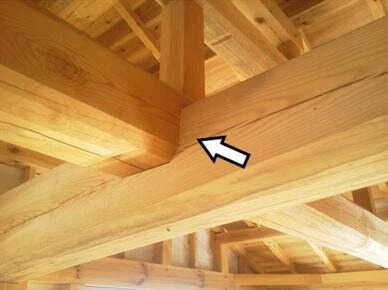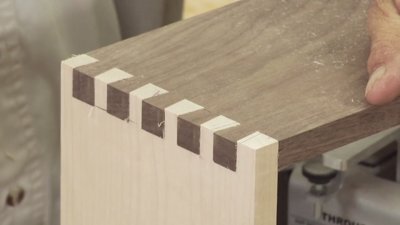The Science Behind Wood Joinery
-f (3).png)
Wood joinery is the craft of connecting pieces of wood together to form a larger, more complex structure without the use of nails, screws or bolts. It is a necessary and essential part of any woodworking project, as it provides strength, stability and flexibility to the final product. Without joinery techniques, a wooden structure would be limited to simple, straight-line designs and 90-degree angles.
There are various types of wood joinery methods, each with its unique advantages and disadvantages. Wood joinery connects two pieces of wood together without the use of metal brackets. Because of this, woodworkers have been using wood joinery for many thousands of years to create sturdy and sometimes artistic furniture. 
In this post, we will delve deeper into the science of wood joinery, including the material properties for joining wood, and the physics behind joinery. 

Material Properties and Requirements for Joining Pieces of Wood
When it comes to joining pieces of wood together, it is important to consider the properties and requirements of the wood being used.
The material properties have a significant impact on the strength and durability of the joint. There are various methods and techniques for joining wood, including butt joints, dovetail joints, and mortise and tenon joints, but each requires different material properties and preparation. 
Below are two considerations that must be made when determining how a craftsman will join two pieces of wood.
Material Selection and Thickness
When selecting wood materials for joinery, it is important to consider factors such as workability, durability, and response to adhesives and finishes. Workability refers to how easily wood can be shaped and cut, while durability ensures that the joint will withstand the test of time. Adhesive and finish compatibility is also crucial, as different types of wood respond differently to these treatments.
Material thickness is another important factor to consider, as it can affect joinery design and mechanical performance. In particular, the size of the notch is directly influenced by the thickness of the material. When using a thicker material, larger notches can be made without compromising the joint's strength. The opposite is true for thinner materials, where smaller notches are required.
Some popular wood species used in furniture making include teak, mahogany, and oak, each has varying physical properties. Teak is resistant to decay and water damage, making it ideal for outdoor furniture. Mahogany is durable and has a natural reddish-brown color that is attractive in many designs. Oak is strong and dense, making it a popular choice for solid wood furniture.
By carefully selecting the right wood materials and considering their thickness, a robust and attractive construction can be achieved.
Cutting Through the Material
Wood joinery involves cutting pieces of wood to fit together in a variety of ways. One type of cut commonly used in wood joinery is the shoulder cut for tenon joints. This type of cut is made at the end of a piece of wood to create a flat surface perpendicular to the grain, allowing the tenon to fit securely into a mortise.
Another type of joint that requires cutting through the material is the “Watari-ago” joint. This joint utilizes a notch shape, with the surface of the notch following consistent directions to ensure elastic volume deformation.
Common power tools used to make these cuts include saws and drills. Saws may be used to make the shoulder cuts for tenon joints, while drills are useful for creating holes or other shapes required for specific joints. When making these cuts, it is important to work carefully and accurately to ensure a robust design and sound wood joints.

The Physics Behind Wood Joinery
Wood joinery involves a variety of techniques that require cutting and shaping pieces of wood to create attractive construction materials. The mechanical and rotational performance of wood joints is influenced by several factors, including elastic volume deformation and calculation of deformation volume. When designing a wood joint, it's essential to assign consistent directions for mating surfaces to ensure that the joint performs as expected. Additionally, the grain direction of the wood can also impact the strength of the joint.
Several common power tools and woodworking tools are used in the design process, including saws, routers, chisels, and drills. Saws are useful for cutting wood, while routers can create complex designs and shapes. Chisels and drills are essential for shaping and creating holes in the wood, respectively.
Understanding the physics behind wood joinery is crucial for modern woodworkers to create pieces of furniture with sound wood joints. Mechanical performance and rotational performance are critical elements in the design process, and the use of appropriate woodworking tools can ensure a robust design. Woodworkers must ensure that each joint has enough friction to stay together. Here are five considerations that affect the outcome of the final wood joint. 
Joinery: Accurate cutting and fitting of the joint components are essential to create tight-fitting connections. This involves using precise measurements, sharp tools, and proper techniques to ensure that the mating surfaces of the joint are in close contact.
Interlocking design: Joints like dovetails, finger joints, and mortise and tenon joints have interlocking elements that increase the surface area of contact, enhancing the friction between the joint components. These interlocking features create mechanical strength that helps hold the joint together.
Proper clamping: Applying appropriate clamping pressure during assembly can help create a strong bond between the joint surfaces. Clamps hold the joint components tightly together while the adhesive dries, ensuring a secure fit.
Mechanical fasteners: In addition to adhesive, woodworkers can use mechanical fasteners, such as dowels, to reinforce the joint. These fasteners provide additional strength and stability to the joint by adding friction and holding the components together.
Wood selection: Choosing the right type of wood can play a role in creating friction and ensuring a secure joint. Some woods have natural properties that enhance their gripping ability, such as wood with interlocking grain patterns or higher density.
The Best Wood Dowels from Atlas Dowel
When working with wood, quality matters. For that reason, when you shop for dowels, you can't afford to compromise. Get the best dowels in the Midwest directly from Atlas Dowel. 
Atlas Dowel provides your business with the highest quality bulk and custom dowels to meet your wood working needs. All our wood dowels are made in America and sourced from forests with responsible forest management. 
For the quality dowels your business needs, click here to shop Atlas Dowel today!
Follow us on Facebook and Twitter for more dowel tips!
Happy with the Atlas Dowel difference? Leave us a five-star review here!

